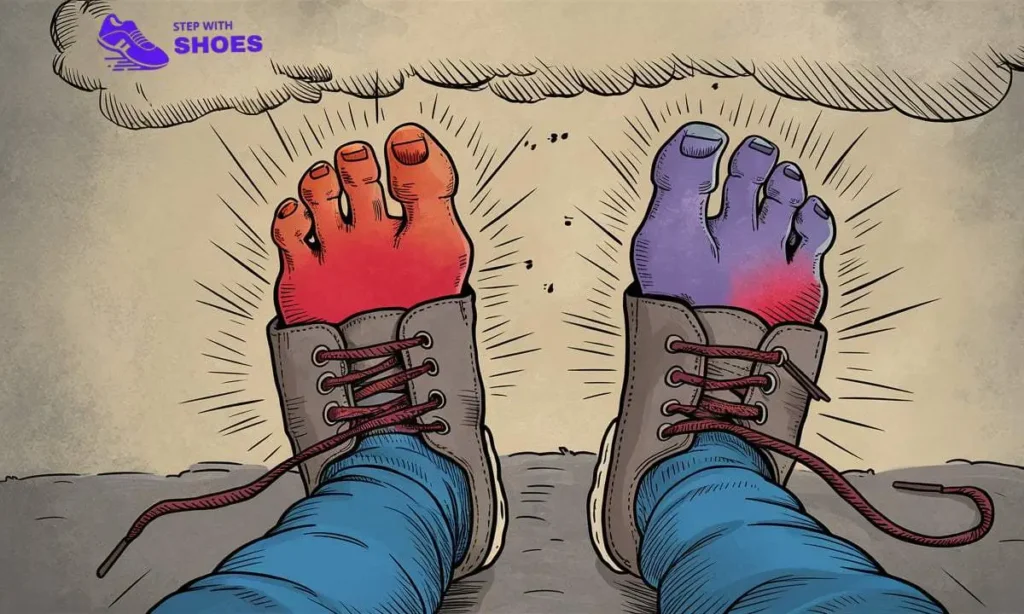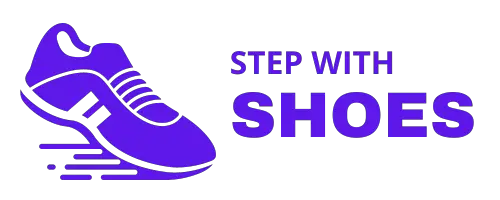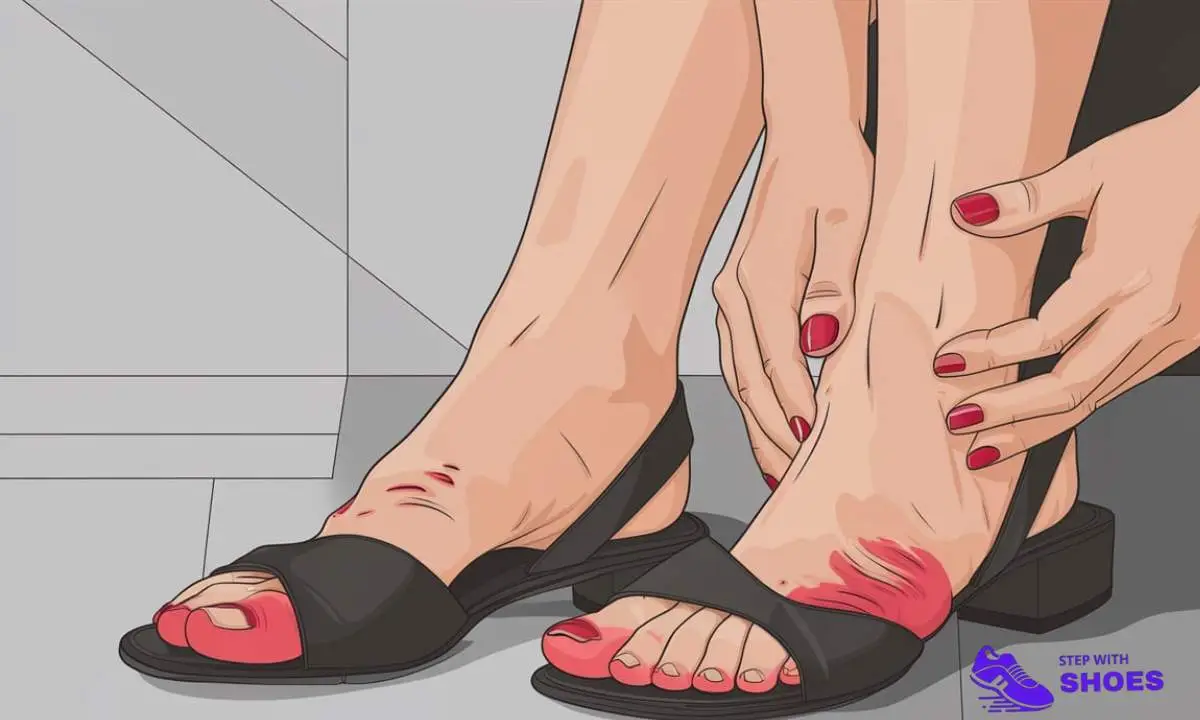Shoes may hurt your feet due to poor fit, lack of support, or inappropriate design. Factors like foot shape and activity level also contribute to discomfort.
Finding the right pair of shoes is essential for foot health. Many people experience pain because they select styles that don’t suit their unique needs. Factors such as arch support, cushioning, and the shoe’s width play a critical role in comfort.
Ill-fitting shoes can lead to blisters, bunions, and other foot problems. High heels and narrow shoes often exacerbate issues, especially for those with wider feet. Understanding your foot type and the activities you engage in can help you choose better footwear. Proper shoes not only enhance comfort but also improve overall mobility and reduce the risk of injury.
The Unseen Culprits Behind Foot Pain
Many people ignore foot pain. They often don’t know the reasons. Understanding these hidden factors can help you find relief.
Mismatched Shoe Size
Wearing the wrong shoe size causes discomfort. This can happen in two ways:
- Too Small: Shoes that are too tight pinch your toes.
- Too Big: Loose shoes can lead to blisters and slipping.
Check the size regularly. Feet can change over time due to various factors:
- Weight gain
- Age
- Health conditions
Always measure both feet. Sizes can differ between shoes.
The Myth Of Breaking In
Many believe shoes need breaking in. This is a common misconception. Shoes should feel comfortable from the start.
Wearing uncomfortable shoes can lead to:
- Blisters
- Corn formation
- Long-term foot problems
Choose shoes that fit well. Look for these features:
| Feature | Why It Matters |
|---|---|
| Arch Support | Helps with weight distribution |
| Padded Insoles | Provides comfort during wear |
| Wide Toe Box | Allows natural toe movement |
Anatomy Of A Shoe: More Than Meets The Eye
Shoes play a crucial role in foot health. Understanding their anatomy helps identify why they may hurt your feet. Each shoe part affects comfort and fit. Let’s explore key components that impact your walking experience.
Sole Hardness And Flexibility
The sole of a shoe is vital for comfort. It comes in different hardness levels:
| Type of Sole | Hardness Level | Flexibility |
|---|---|---|
| Rigid Sole | High | Low |
| Soft Sole | Low | High |
- Rigid soles may lead to discomfort.
- Soft soles offer better cushioning.
- Flexibility helps in natural foot movement.
Choose a sole that matches your activity. For running, a flexible sole is ideal. For formal occasions, a rigid sole may work.
Toe Box Dimensions
The toe box is the front part of the shoe. Its dimensions greatly affect comfort:
- Width: A narrow toe box may squeeze your toes.
- Height: Insufficient height can cause discomfort.
Consider these tips for a better fit:
- Measure your feet regularly.
- Try shoes in the afternoon, when feet swell.
- Ensure there’s space for toes to wiggle.
A well-fitted toe box prevents blisters and pain. Always prioritize comfort over style.
Walking The Tightrope: High Heels And Foot Health
High heels can add style, but they come at a cost. Wearing them often leads to foot pain. Many women love the look but suffer from discomfort. Understanding how high heels affect feet is crucial.
The Strain On The Achilles Tendon
High heels significantly impact the Achilles tendon. This tendon connects the calf muscles to the heel bone. Wearing heels shortens the calf muscles over time. The result? Increased tension on the Achilles tendon.
This strain can lead to:
- Pain in the back of the heel
- Stiffness in the calf muscles
- Risk of tendonitis
Many women experience discomfort after a long day in heels. Stretching exercises can help. Regular stretching keeps the calf muscles flexible.
Pressure Points: Ball Of The Foot
High heels shift weight forward. This puts extra pressure on the ball of the foot. Prolonged pressure causes pain and discomfort. It can also lead to issues like:
- Metatarsalgia: Pain in the ball of the foot
- Bunions: Bony bumps on the joint of the big toe
- Neuromas: Thickening of tissue around nerves
To reduce pressure:
- Choose heels with a wider toe box
- Limit the height of the heels
- Use padded insoles
Taking breaks while wearing high heels can help. Shift weight to the heels occasionally. This simple act can provide relief.
Sneaker Secrets: When Comfort Turns To Pain
Sneakers often promise comfort but can lead to foot pain. Understanding why your shoes hurt helps you make better choices. Let’s uncover common issues that cause discomfort.

Lack Of Arch Support
Many sneakers lack proper arch support. This can lead to foot pain and fatigue. Your arch plays a crucial role in foot health.
- Flat shoes can worsen foot problems.
- High arches need support too.
- Custom insoles can help.
When arches aren’t supported, it leads to:
- Plantar fasciitis
- Heel pain
- Improper alignment
Breathability And Foot Health
Sneakers made from non-breathable materials trap moisture. This creates a warm environment for bacteria. Over time, this can lead to:
| Issue | Description |
|---|---|
| Odor | Unpleasant smells from bacteria growth. |
| Blisters | Friction due to sweat and tight fit. |
| Fungal Infections | Moist environments promote athlete’s foot. |
Choose sneakers with breathable materials. Look for mesh uppers to enhance airflow. Your feet will thank you for it.
Material Matters: How Shoe Fabric Affects Your Feet
The choice of shoe material directly impacts comfort and foot health. Different fabrics can cause pain, discomfort, or even allergies. Understanding these materials helps in making better shoe choices.
Synthetic Vs Natural
Synthetic materials include plastics and artificial fibers. They are often cheaper and more durable. However, they can cause overheating and sweat buildup. This may lead to blisters and discomfort.
Natural materials, such as leather and cotton, offer breathability. They allow air circulation, keeping feet cool and dry. Natural fabrics adapt better to foot shape, enhancing comfort. Here’s a quick comparison:
| Material Type | Advantages | Disadvantages |
|---|---|---|
| Synthetic | DurableCost-effective | Can cause sweatingLess breathable |
| Natural | BreathableComfortable fit | Can be expensiveMay require more care |
The Allergy Factor
Some materials trigger foot allergies. Common allergens include certain adhesives and synthetic fabrics. Symptoms may include itching, redness, and swelling.
Identifying the right material can prevent these issues. Here are some tips:
- Choose shoes made from natural fibers.
- Look for hypoallergenic labels.
- Test new shoes at home.
Be aware of your body’s reactions. If discomfort occurs, consider switching materials. Your feet deserve the best care.
Foot Shape And Shoe Choice: A Personal Puzzle
Finding the right shoes can be tricky. Your foot shape plays a big role. Shoes that fit poorly can cause pain. Understanding your foot type helps in making better choices.
Recognizing Your Foot Type
Different foot shapes need different types of shoes. Here are the common foot types:
| Foot Type | Characteristics | Best Shoe Type |
|---|---|---|
| Flat Feet | Low arches, wide foot | Supportive shoes with cushioning |
| High Arches | High arches, narrow foot | Flexibility with cushioning |
| Neutral Feet | Normal arches, balanced width | Versatile shoes for various activities |
Knowing your foot type helps in selecting the right shoes. You can measure your foot length and width at home. This gives you a better idea of your foot shape.
Custom Orthotics And Insoles
Sometimes, standard shoes don’t offer enough support. Custom orthotics and insoles can help. They provide extra comfort and improve foot alignment.
- Benefits of Custom Orthotics:
- Reduces pain in the arch and heel
- Improves balance and stability
- Enhances overall comfort
- Types of Insoles:
- Gel insoles for cushioning
- Foam insoles for support
- Arch support insoles for flat feet
Consulting a podiatrist can help in choosing the right orthotics. They can analyze your foot structure and recommend solutions.
The Science Of Walking: Gait Analysis And Footwear
Understanding how we walk helps us choose the right shoes. Gait analysis studies our walking patterns. It reveals how our feet move and interact with the ground. This knowledge is crucial for avoiding foot pain.
Identifying Abnormalities
Many people have unique walking patterns. These patterns can cause foot pain. Gait analysis helps identify abnormalities. Here are some common issues:
- Overpronation: Feet roll inward too much.
- Supination: Feet roll outward excessively.
- Flat Feet: Arches are lower than normal.
- High Arches: Arches are higher than normal.
Recognizing these issues is the first step. A professional can analyze your gait. They may use a treadmill and video analysis. This helps determine the right footwear.
Choosing Shoes For Your Gait
Selecting shoes that match your gait is vital. The wrong shoes can lead to pain. Here’s how to choose wisely:
| Gait Type | Recommended Shoe Type | Features to Look For |
|---|---|---|
| Overpronation | Stability shoes | Supportive cushioning, firm heel |
| Supination | Neutral cushioned shoes | Soft cushioning, flexible sole |
| Flat Feet | Motion control shoes | Stability, arch support |
| High Arches | Cushioned shoes | Extra padding, shock absorption |
Try on shoes at the end of the day. Feet swell and become larger. Always walk around the store. This ensures comfort and fit.
Healing Steps: Solutions To Shoe-induced Foot Pain
Shoe-induced foot pain is common. Finding the right solutions can help. Below are effective steps to ease your discomfort.
Proper Shoe Fitting Tips
Wearing the right shoes is essential. Follow these tips for proper fitting:
- Measure Your Feet: Use a ruler or a measuring tape.
- Try Shoes at the End of the Day: Feet swell during the day.
- Check Width and Length: Shoes should fit snugly, not tight.
- Walk Around: Test comfort in the store.
- Look for Arch Support: Choose shoes that support your foot’s arch.
Remember these points:
| Tip | Benefit |
|---|---|
| Measure Your Feet | Ensures the right size. |
| Try Shoes at End of Day | Accounts for swelling. |
| Check Width and Length | Avoids pinching and discomfort. |
When To Seek Professional Help
Some foot pain needs expert care. Watch for these signs:
- Persistent Pain: Pain lasts longer than a week.
- Swelling: Noticeable swelling in your feet.
- Deformities: Bunions or other changes in foot shape.
- Difficulty Walking: Struggle to walk without pain.
- Rashes or Sores: Skin problems that won’t heal.
Seeking help early can prevent further issues. A podiatrist can provide tailored advice and treatment.
Frequently Asked Questions
Why Do My Feet Hurt When I Wear Shoes?
Feet may hurt in shoes due to poor fit, lack of support, or inadequate cushioning. High heels and narrow designs can exacerbate discomfort. Other factors include foot conditions like plantar fasciitis or bunions. Choosing the right footwear and using orthotics can alleviate pain and improve comfort.
How Do You Make Your Shoes Stop Hurting Your Feet?
To stop your shoes from hurting your feet, try wearing thicker socks for cushioning. Use insoles for better support. Choose the right shoe size and style. Break in new shoes gradually. Stretch your shoes with a shoe stretcher if they’re too tight.
Always prioritize comfort over style.
What Can I Put On My Feet So Shoes Don’t Hurt?
Use cushioned insoles for extra comfort. Apply blister prevention pads on sensitive areas. Wear moisture-wicking socks to reduce friction. Consider arch support inserts for better alignment. Choose shoe stretchers to ease tight spots. Regularly adjust shoe laces for a better fit.
Conclusion
Finding the right shoes is essential for comfort and foot health. Ill-fitting footwear can lead to pain and long-term issues. Always consider factors like size, arch support, and materials. Taking the time to choose the right pair can make a significant difference in your daily comfort and overall foot well-being.



Leave a Reply